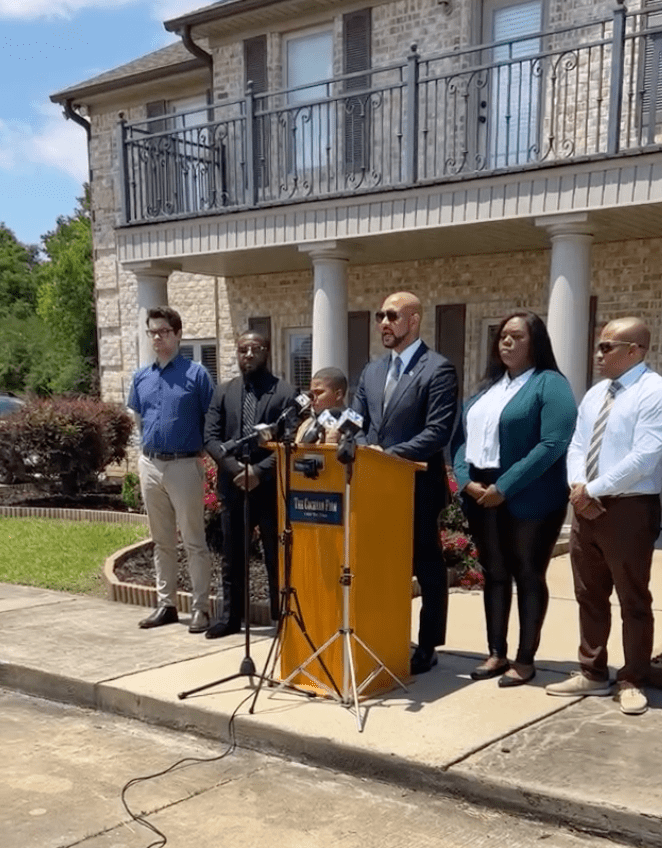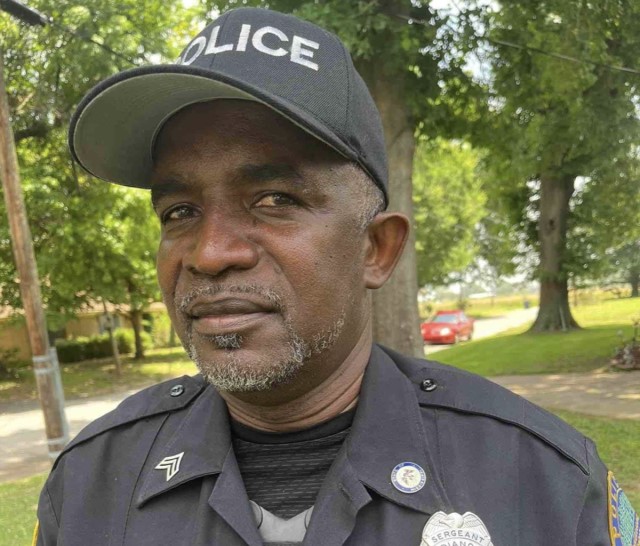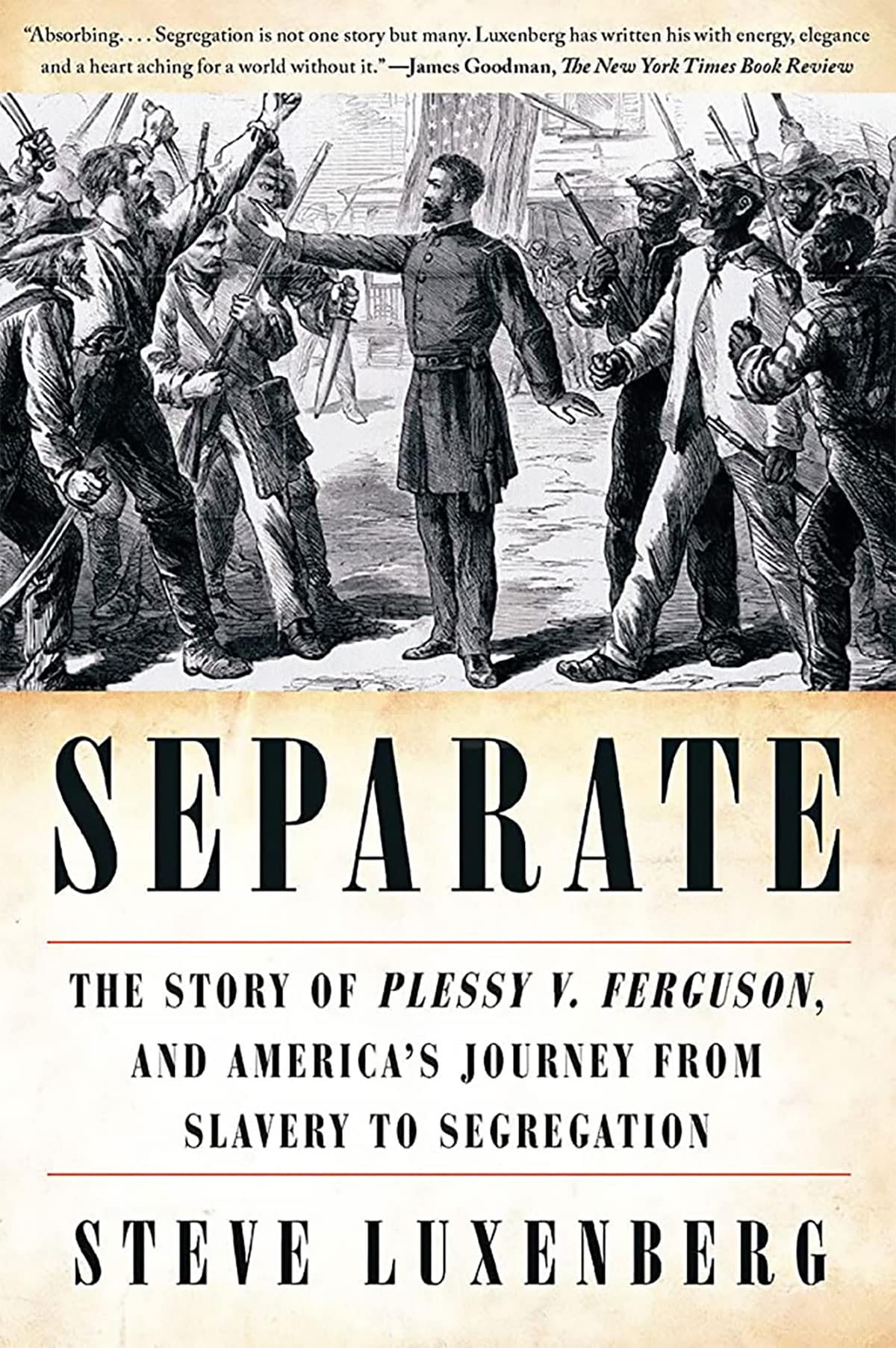Mississippi Today
Mother of 11-year-old shot by Indianola officer demands public release of body camera footage

Nearly seven months after an Indianola police officer shot an 11-year-old boy in the chest during a domestic call, the boy's mother has finally seen the body camera footage and is asking for it to be released publicly.
“Watching that footage was nothing I was prepared for emotionally, but it was something I had to do,” Nakala Murry, the mother of Aderrien, said Wednesday during a press conference in Grenada. “I feel disgusted, outraged and emotionally damaged, but in all of those feelings I feel blessed. This has been a process of fighting for justice for my son.”
The early morning of May 20, police were called to the Murry home because the father of her younger child had come there and his behavior was worrying. Officer Greg Capers, one of the officers standing in the doorway, fired his weapon as Aderrien entered the room, hitting the boy in the chest.
Until last week, Nakala Murry had not been able to see Capers' body camera footage, said her attorney, Carlos Moore.
Arguments for and against the release of the body camera video have played out in a federal lawsuit Murry filed in May against Capers, the city and Police Chief Ronald Sampson.

The city and police chief asked for the video to be sealed from public view to protect Aderrien's privacy, but his name has been public since the shooting.
Moore filed a motion to compel the release of the video, which a judge approved last week but with restrictions: Nakala Murry, Moore and his legal team could view it, but they would not be allowed to share the video or any description about it publicly.
Although they are not able to release the video, the city can.
“I am here to demand the city of Indianola release it to the public,” Moore said Wednesday.
That day, Moore filed an objection to U.S. Magistrate Judge David Sanders' order, making it clear that they wanted to be able to disseminate the body camera video and talk about it. Moore wrote that the evidence should have been filed with the circuit clerk's office – making it a public record.
That order will be appealed, Moore said. He said there is no set timeline of when the district court judge would make a ruling, but he hopes they will rule in his client's favor and side with the public.
Michael Carr, who is representing Capers, previously told Mississippi Today that the shooting was an accident and that body camera footage would show that. Capers thought the person he shot at was the adult man they were called about, not a child, according to court records.

After the shooting, Capers was placed on paid administrative leave and later that leave was changed to unpaid leave. Capers went before the Board of Aldermen most recently in November to ask for his job back, but his return has not been approved, the Enterprise-Tocsin reported.
Moore and Murry said Capers should be terminated and no longer be able to work as a police officer.
She is also pursuing criminal charges against Capers related to Aderrien's shooting. A probable cause hearing, which would determine whether evidence exists for Capers to be charged and arrested, has not been held yet.
While the past months have been difficult, she said, she is hopeful. Aderrien is doing better with the help of counseling and support from family and friends, and he sees how his mother is standing up for him.
Nakala Murry prays that the right thing is done, and that what happened to her son can serve as an opportunity to hold officers accountable.
“Every day is a fight, but it's one I'm willing to take,” she said.
This article first appeared on Mississippi Today and is republished here under a Creative Commons license.
Did you miss our previous article…
https://www.biloxinewsevents.com/?p=314606
Mississippi Today
On this day in 1896


MAY 18, 1896

The U.S. Supreme Court ruled 7-1 in Plessy v. Ferguson that racial segregation on railroads or similar public places was constitutional, forging the “separate but equal” doctrine that remained in place until 1954.
In his dissent that would foreshadow the ruling six decades later in Brown v. Board of Education, Justice John Marshall Harlan wrote that “separate but equal” rail cars were aimed at discriminating against Black Americans.
“In the view of the Constitution, in the eye of the law, there is in this country no superior, dominant, ruling class of citizens,” he wrote. “Our Constitution in color-blind and neither knows nor tolerates classes among citizens. In respect of civil rights, all citizens are equal before the law. The humblest is the peer of the most powerful. The law … takes no account of his surroundings or of his color when his civil rights as guaranteed by the supreme law of the land are involved.”
This article first appeared on Mississippi Today and is republished here under a Creative Commons license.
Did you miss our previous article…
https://www.biloxinewsevents.com/?p=359301
Mississippi Today
Renada Stovall, chemist and entrepreneur
Renada Stovall sat on the back deck of her rural Arkansas home one evening, contemplating life when she had a life-altering epiphany…
“I gotta get out of these woods.”
She heard it as clear as lips to her ear and as deep as the trees surrounding her property. Stovall's job as a chemist had taken her all over the country. In addition to Arkansas, there were stints in Atlanta, Dallas and Reno. But she was missing home, her parents and friends. She also knew, she needed something else to do.
“I thought, what kind of business can I start for myself,” said Stovall, as she watered herbs growing in a garden behind her south Jackson home. Some of those herbs are used in her all-natural products. “I know when I lived in Reno, Nevada, where it's very hot and very dry, there really weren't products available that worked for me, my hair, and my skin suffered. I've got a chemistry degree from Spelman College. I took the plunge and decided to create products for myself.”

In 2018, Stovall's venture led to the creation of shea butter moisturizers and natural soaps. But she didn't stop there, and in December 2022, she moved home to Mississippi and got to work, expanding her product line to include body balms and butters, and shampoos infused with avocado and palm, mango butter, coconut and olive oils.
Nadabutter, which incorporates Renada's name, came to fruition.

Stovall sells her balms and moisturizers at what she calls, “pop-up markets,” across the state during the summer. She's available via social media and also creates products depending on what of her ingredients a customer chooses. “My turmeric and honey is really popular,” Stovall added.
“The all-natural ingredients I use are great for conditioning the skin and hair. All of my products make you feel soft and luscious. The shea butter I use comes from West Africa. It's my way of networking and supporting other women. And it's my wish that other women can be inspired to be self-sufficient in starting their own businesses.”





This article first appeared on Mississippi Today and is republished here under a Creative Commons license.
Mississippi Today
On this day in 1954
MAY 17, 1954

In Brown v. Board of Education and Bolling v. Sharpe, the U.S. Supreme Court unanimously ruled that the “separate but equal” doctrine in Plessy v. Ferguson was unconstitutional under the 14th Amendment, which guaranteed equal treatment under the law.
The historic decision brought an end to federal tolerance of racial segregation, ruling in the case of student Linda Brown, who was denied admission to her local elementary school in Topeka, Kansas, because of the color of her skin.
In Mississippi, segregationist leaders called the day “Black Monday” and took up the charge of the just-created white Citizens' Council to preserve racial segregation at all costs.
This article first appeared on Mississippi Today and is republished here under a Creative Commons license.
-
SuperTalk FM6 days ago
Martin Lawrence making 3 stops in Mississippi on comedy tour
-
Our Mississippi Home4 days ago
Beat the Heat with Mississippi’s Best Waterparks
-
SuperTalk FM2 days ago
State auditor cracking down on Mississippians receiving unemployment benefits
-
Our Mississippi Home5 days ago
Charlie’s U-Pik: Opening Soon for the Summer Season
-
Mississippi News Video4 days ago
Jackson has a gang problem
-
Kaiser Health News5 days ago
Medicaid ‘Unwinding’ Decried as Biased Against Disabled People
-
228Sports4 days ago
George County Pours Runs In 6A South State Title Victory At PRC
-
Local News1 day ago
Family files lawsuit after teen’s suicide in Harrison County Jail









































